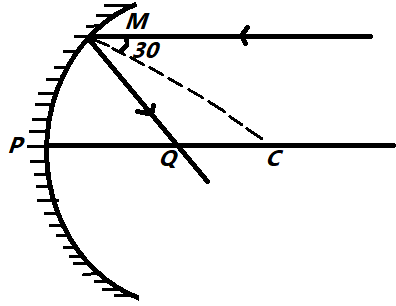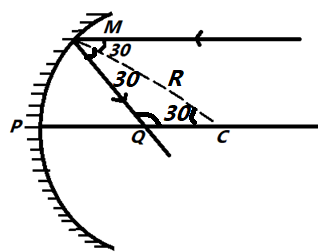
A ray parallel to the principal axis is incident at ${30^ \circ }$ from a normal concave mirror having radius of curvature $R$ . The point on principal axis where rays are focused is $Q$ such that $PQ$ is

A. $\dfrac{R}{2}$
B. $\dfrac{R}{{\sqrt 3 }}$
C. $\dfrac{{2\sqrt R - R}}{{\sqrt 2 }}$
D. $R\left( {1 - \dfrac{1}{{\sqrt 3 }}} \right)$
Answer
218.7k+ views
Hint: A ray parallel to the main axis will reflect and then pass through the main focus in a concave mirror. With a convex mirror, it appears to veer away from the main focus. After reflection, a ray going through a concave mirror's primary focus will come out parallel to the main axis. The supplied ray will therefore pass through the main focus after the first reflection, and after the second reflection, it will emerge parallel to the main axis.
Formula used:
1. Mirror Formula:
$\dfrac{1}{f} = \dfrac{1}{v} + \dfrac{1}{u}$ … (1)
Here, $f$ is the focal length of the mirror,
$u$ is the object distance and
$v$ is the image distance.
2. Focal length
$f = \dfrac{R}{2}$
where , R is Radius of curvature
Complete answer:
We have been given the data that,
A ray parallel to principal axis is incident at \[{30^ \circ }\] from normal on concave mirror having radius of curvature \[R\]
From the given diagram, we can write as,
From similar triangles, we can write the equation as
\[ = \dfrac{QC}{\sin {{30}^\circ }} = \dfrac{R}{\sin {{120}^\circ }}\]
Now, the equation (1) can be written in terms of \[{\rm{QC}}\] as,
\[{\rm{QC}} = {\rm{R}} \times \dfrac{{\sin {{30}^\circ }}}{{\sin {{120}^\circ }}}\]
We have to solve the above using the identity \[\sin \left( x \right) = \cos \left( {{{90}^{^\circ \:}} - x} \right)\]:
\[ = \dfrac{{\sin \left( {{{30}^{^\circ \:}}} \right)}}{{\cos \left( {{{90}^{^\circ \:}} - {{120}^{^\circ \:}}} \right)}}\]
Let’s use the property \[\cos \left( { - x} \right) = \cos \left( x \right)\]:
\[ = \dfrac{{\sin \left( {{{30}^{^\circ \:}}} \right)}}{{\cos \left( { - {{30}^{^\circ \:}}} \right)}}\]
On simplifying the above, we get
\[ = \dfrac{{\rm{R}}}{{\sqrt 3 }}\]
Thus, we have
\[{\rm{PQ}} = {\rm{PC}} - {\rm{QC}}\]
We can write as,
\[ = {\rm{R}} - \dfrac{{\rm{R}}}{{\sqrt 3 }}\]
We have to take \[{\rm{R}}\] as common, we obtain
\[ = {\rm{R}}\left( {1 - \dfrac{1}{{\sqrt 3 }}} \right)\]
Therefore, the point on principal axis where rays are focused is \[Q\] such that \[PQ\] is \[{\rm{R}}\left( {{\rm{1}} - \dfrac{1}{{\sqrt 3 }}} \right)\]
Hence, the option D is correct.

Note:Students make mistakes in these types of issues, because these types of problems include trigonometry problems. So, they should be careful in applying formulas to get the desired solution.
Formula used:
1. Mirror Formula:
$\dfrac{1}{f} = \dfrac{1}{v} + \dfrac{1}{u}$ … (1)
Here, $f$ is the focal length of the mirror,
$u$ is the object distance and
$v$ is the image distance.
2. Focal length
$f = \dfrac{R}{2}$
where , R is Radius of curvature
Complete answer:
We have been given the data that,
A ray parallel to principal axis is incident at \[{30^ \circ }\] from normal on concave mirror having radius of curvature \[R\]
From the given diagram, we can write as,
From similar triangles, we can write the equation as
\[ = \dfrac{QC}{\sin {{30}^\circ }} = \dfrac{R}{\sin {{120}^\circ }}\]
Now, the equation (1) can be written in terms of \[{\rm{QC}}\] as,
\[{\rm{QC}} = {\rm{R}} \times \dfrac{{\sin {{30}^\circ }}}{{\sin {{120}^\circ }}}\]
We have to solve the above using the identity \[\sin \left( x \right) = \cos \left( {{{90}^{^\circ \:}} - x} \right)\]:
\[ = \dfrac{{\sin \left( {{{30}^{^\circ \:}}} \right)}}{{\cos \left( {{{90}^{^\circ \:}} - {{120}^{^\circ \:}}} \right)}}\]
Let’s use the property \[\cos \left( { - x} \right) = \cos \left( x \right)\]:
\[ = \dfrac{{\sin \left( {{{30}^{^\circ \:}}} \right)}}{{\cos \left( { - {{30}^{^\circ \:}}} \right)}}\]
On simplifying the above, we get
\[ = \dfrac{{\rm{R}}}{{\sqrt 3 }}\]
Thus, we have
\[{\rm{PQ}} = {\rm{PC}} - {\rm{QC}}\]
We can write as,
\[ = {\rm{R}} - \dfrac{{\rm{R}}}{{\sqrt 3 }}\]
We have to take \[{\rm{R}}\] as common, we obtain
\[ = {\rm{R}}\left( {1 - \dfrac{1}{{\sqrt 3 }}} \right)\]
Therefore, the point on principal axis where rays are focused is \[Q\] such that \[PQ\] is \[{\rm{R}}\left( {{\rm{1}} - \dfrac{1}{{\sqrt 3 }}} \right)\]
Hence, the option D is correct.

Note:Students make mistakes in these types of issues, because these types of problems include trigonometry problems. So, they should be careful in applying formulas to get the desired solution.
Recently Updated Pages
A square frame of side 10 cm and a long straight wire class 12 physics JEE_Main

The work done in slowly moving an electron of charge class 12 physics JEE_Main

Two identical charged spheres suspended from a common class 12 physics JEE_Main

According to Bohrs theory the timeaveraged magnetic class 12 physics JEE_Main

ill in the blanks Pure tungsten has A Low resistivity class 12 physics JEE_Main

The value of the resistor RS needed in the DC voltage class 12 physics JEE_Main

Trending doubts
JEE Main 2026: Application Form Open, Exam Dates, Syllabus, Eligibility & Question Papers

Understanding Uniform Acceleration in Physics

Derivation of Equation of Trajectory Explained for Students

Hybridisation in Chemistry – Concept, Types & Applications

Understanding the Angle of Deviation in a Prism

Understanding Collisions: Types and Examples for Students

Other Pages
JEE Advanced Marks vs Ranks 2025: Understanding Category-wise Qualifying Marks and Previous Year Cut-offs

Understanding Atomic Structure for Beginners

How to Convert a Galvanometer into an Ammeter or Voltmeter

Understanding Centrifugal Force in Physics

JEE Main Marking Scheme 2026- Paper-Wise Marks Distribution and Negative Marking Details

Degree of Dissociation: Meaning, Formula, Calculation & Uses




